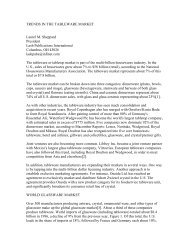eu market survey 2003 - crecer
eu market survey 2003 - crecer
eu market survey 2003 - crecer
You also want an ePaper? Increase the reach of your titles
YUMPU automatically turns print PDFs into web optimized ePapers that Google loves.
These developments have both a negative and a positive effect on the table- & kitchenware sales.<br />
The <strong>market</strong> for basic products like pans, gadgets, etc. is growing because of the steadily<br />
increasing number of households. On the downside, these smaller households do not need the<br />
large table- & kitchenware sets often sold in the premium-end of the <strong>market</strong>.<br />
Marriage rates & timing<br />
According to Euromonitor, the number of marriages is an important sales driver in the table- &<br />
kitchenware <strong>market</strong> especially in the premium-end of the <strong>market</strong>. Traditionally table- &<br />
kitchenwares make up a substantial share of the wedding gifts given.<br />
The marriage rate in the EU is steadily dropping. Pre-marriage households are very common.<br />
According to Eurostat, the EU marriage rate dropped from an average of 6.3 marriages per 1000<br />
inhabitants in 1980, to 5.1 marriages in 2002. Many people today choose to delay their marriage<br />
until they are somewhat older. This development has some implications, especially for the<br />
premium table- & kitchenware segment, as for example crockery sets and crystalware. Because of<br />
this development, couples each tend to have well-equipped homes, making wedding gifts of<br />
table- & kitchenware redundant.<br />
3.3.2 Social & cultural trends<br />
There are significant changes in consumption habits in the varying EU-countries, due to<br />
improvement of life, and differences in culture, traditions and tastes. In this section, the main<br />
social trends which influence the consumption of table- & kitchenware will be discussed.<br />
Turning inwards<br />
According to the Ambiente, a slumbering economy turns consumers more inwards to their homes<br />
and kitchens. Consumers are spending more time on social events at home like dining, playing<br />
games, etc., with family and friends, combined with the rise of in-home entertainment systems,<br />
which are good and cheap alternatives of out-of-home possibilities. This phenomenon of<br />
”staying-in”, according to Global Information Inc., has a positive effect on table- & kitchenware<br />
sales.<br />
From formal to casual<br />
Another important development is the shift from formal to more casual everyday table- &<br />
kitchenware. According to Unity Marketing, today’s consumers more often buy this casual<br />
everyday table- & kitchenware rather than the higher-priced formal tableware which is the<br />
traditional cornerstone of the industry. Other relevant social trends are discussed below.<br />
Changing eating and cooking habits<br />
As mentioned earlier, the EU consumption of table- & kitchenware is steadily shifting away from<br />
formal products towards more practical and informal products. According to Euromonitor, the<br />
busier lifestyles, the increasing number of single-person households and a growing number of<br />
working women, lead to changing lifestyles. Family meals are being replaced by “grazing”, as<br />
consumers eat more easy-to-prepare snacks during the day rather than a formal meal. This trend is<br />
more pronounced in the Western countries of Europe. However, even in countries with a<br />
significant, traditional dining culture, like Italy and France, this trend is also evident. The<br />
tradition of long, extensive meals is being replaced by convenient, ready-made meals, which take<br />
less time to prepare.<br />
There is also a growing trend towards health and wellbeing. Today’s stressful society has a<br />
positive effect on the sales of health-related products. Fat-free or low-fat products are very<br />
popular throughout many food product ranges. In the table- & kitchenware <strong>market</strong>, this trend has<br />
a significant impact on food preparation methods. Low fat or even fat free cooking methods, like<br />
for example steaming, increasingly substitute less healthy cooking methods like frying and<br />
roasting. Low-fat cookware like grills, steamers and woks has become more popular in the<br />
reviewed period.<br />
26





